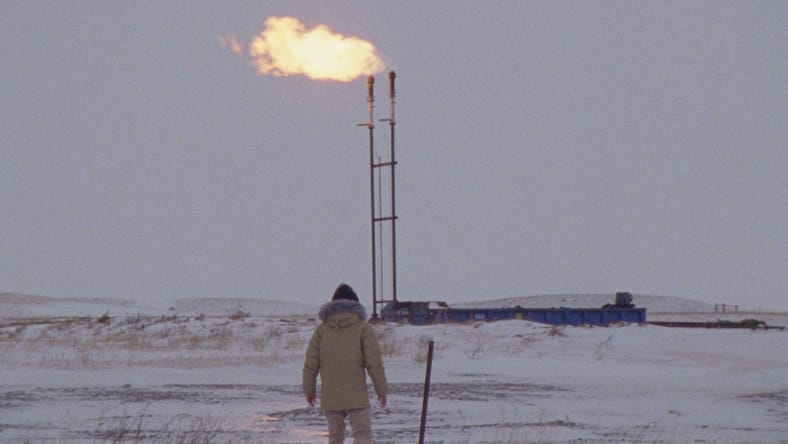
How to Blow Up a Pipeline, the new movie by director Daniel Goldhaber, is an eco-thriller that burns with anger toward fracking — and the story a generation with a grim outlook of the future.
Goldhaber’s movie, which he co-wrote with Ariela Barer and Jordan Sjol, is based on Andreas Malm’s 2021 radical manifesto, which argues that there’s a moral obligation to destroy fossil-fuel infrastructure. They adapted the book by creating an original story based on the ideas detailed in the book. (On Friday, April 21, a week after the original publication of this story, Rolling Stone reported that the FBI has issued 35 warnings that the film could inspire real-life attacks. )
How to Blow Up a Pipeline doesn’t have a lead protagonist and tells the collective experience of a permanent underclass. However, the Native American character Michael, played by actor and executive producer Forrest Goodluck (The Revenant), sets the ideological tone. The movie’s characters are drawn to Michael’s TikTok account, where he teaches people to sabotage the fuel industry.
“If the American empire calls us terrorists,” Michael says in the film, “then we’re doing something right.”
How to Blow Up a Pipeline, which has a 95% rating on Rotten Tomatoes, opened last weekend with $120,000 in ticket sales in 12 locations, and expands this weekend. MovieMaker spoke with Goldhaber (who’s previous film was 2018’s Cam) about creating characters who believe they need to take action to prevent a climate disaster. We also ask the director if he believes the thesis of Malm’s manifesto: there’s a moral obligation to destroy fossil fuel infrastructure.
Joshua Encinias: Why did you decide to adapt the manifesto as an original story?
Daniel Goldhaber: The flashpoint of inspiration from the book was the combination of the title and the ideas. The book is almost screaming out to be a heist or action movie. It’s also a matter of wanting to take ideas that often exist on the fringes of the progressive or activist movement and really try to spark conversation in the mainstream using the narrative storytelling tools of the mainstream to do that.
There’s something provocative about using rhythms that are frequently associated with genre film and action film to tell a story that is about something so politically provocative and subversive.
How to Blow Up a Pipeline Director Daniel Goldhaber on the Necessity Defense
Joshua Encinias: The book’s author, Andreas Malm, says the existential threat climate change poses to humans means there’s a moral obligation to destroy fossil fuel infrastructure. Do you agree with him?
Daniel Goldhaber: [Long pause.] I think there’s a case to be made that the destruction of fossil fuel infrastructure is an act of self-defense. At the same time, as in any act of self-defense, there is collateral damage and consequences to it. The film’s characters believe what they’re doing is an act of self-defense, while also being frank and upfront about some of the costs and consequences of that very act.
[Pauses.] There’s the necessity defense, which is a legal defense that asserts this exact question. There are valve turners who have made a necessity defense, and there will be more and more of these coming. It will create a legal precedent that if a machine is threatening your life and the lives of your children and everybody else on planet earth, that you have a right to destroy it. I believe that the necessity defense deserves its day in court. 100%.
Also Read: Boston Marathon Bombing Doc Director on What He Would Ask Dzhokhar Tsarnaev
Joshua Encinias: Was Malm involved in the production of How to Blow Up a Pipeline?
Daniel Goldhaber: He was involved from the very beginning. We reached out to him and a lot of the initial activists, journalists, thinkers we consulted came from Andreas. As we were developing and refining the material, we were always able to consult him.
At the same time, we were very upfront with him from the beginning that the film would incorporate the criticisms of the book as well. Whereas the book is directly calling for this action, once you dramatize stuff, it brings on a human dimension that complicates its ideas.
Making How to Blow up a Pipeline
Joshua Encinias: “Form follows function” can be said about almost any movie, but I feel it tangibly here with your use music, color, film stock, editing, how you tell the character’s backstories, et cetera.
Daniel Goldhaber: I really appreciate that line because form did follow function basically as a rule. We made the movie very quickly. There was very little prep time and that was not necessarily by design.
It’s always nice to have more time, but this is a movie about a youthful, spontaneous, impulsive act of necessity and we wanted to make the movie in a way that felt the same, or at least, we justified the way we made the movie by saying this process follows function.
So for example, when we chose to shoot on 16 millimeter, part of that was to capture daylight exteriors in a way that was beautiful, colorful, and have a raw grit to it. And you’re not going to get that shooting digital daytime exteriors.
Joshua Encinias: Why is it the movie’s Indigenous character Michael who creates and handles the bombs?
Daniel Goldhaber: We did a lot of on the ground research for the film and Ajuawak Kapashesit, one of cultural consultants we were speaking to, really informed our approach to the development of Michael as a Native and Indigenous character.

Ajuawak said the Indigenous people he knows on the fringes of the activist movement have a depth to their anger that’s unimaginable and all-consuming. The energy is sometimes frightening to be around. That was a guiding light for the character of Michael.
So when it came to the question of who’s going to teach themselves how to make bombs and who’s going to lead on that level, that was one of the reasons why it made sense for it to be Michael.
Joshua Encinias: I think audiences might be surprised by the character of Dwayne (Jake Weary), a conservative land owner who lost his home to eminent domain.
Daniel Goldhaber: My co-writer Jordan Sjol and I have spent a lot of time talking to people who hold a conservative perspective of land rights, and they’re involved in environmentalism. It’s important to remember that the environmental movement was initially a conservative movement.
The first real environmentalist president that exists in the way that we think about it was Teddy Roosevelt. There was a big thing of “conservation is in the word conservative.” And the way in which the conservative movement departed from environmentalism only happened in the last 30 or 40 years.
We were at the Standing Rock protests, and some of the people who were extraordinarily supportive of the protesters really surprised me. We’re talking like Trump supporters and Trump voters who felt like what was happening to the Standing Rock protesters was unconscionable and unimaginable.
Conservative belief in the environment, living off the land, and people’s connection to the land in that part of the country is really palpable.
Joshua Encinias: What’s your opinion of the media’s reporting on the Nord Stream Pipeline’s sabotage?
Daniel Goldhaber: I was frustrated by it because our movie talks about pipeline destruction as a form of political praxis for the environmental movement, in which our protagonists are exceptionally careful to sabotage and destroy this pipeline without causing environmental damage.
What happened to the Nord Stream pipeline, whoever did it, is the exact opposite. Its destruction created one of the single largest releases of methane gas in history. It is an environmental catastrophe. I think that was not something that was done to protest the nature of the fossil fuel industry.
My frustration is that I think it created a relationship, culturally, between the destruction of pipelines and a very different political machination that certainly is contrary to what we’re talking about in the film.
How to Blow Up a Pipeline is in theaters now, from NEON.
Main image: A still from How to Blow Up a Pipeline, courtesy of NEON.
Share:

